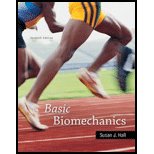
Basic Biomechanics
7th Edition
ISBN: 9780073522760
Author: Susan J Hall
Publisher: McGraw-Hill Education
expand_more
expand_more
format_list_bulleted
Concept explainers
Textbook Question
Chapter 5, Problem 3AP
How is articular cartilage similar to and different from ordinary sponge? (You may wish to consult the Annotated Readings.)
Expert Solution & Answer
Want to see the full answer?
Check out a sample textbook solution
Chapter 5 Solutions
Basic Biomechanics
Ch. 5 - Prob. 1IPCh. 5 - Describe the directions and approximate ranges of...Ch. 5 - Prob. 3IPCh. 5 - Prob. 4IPCh. 5 - What factors contribute to flexibility?Ch. 5 - Prob. 6IPCh. 5 - How is flexibility related to the likelihood of...Ch. 5 - Prob. 8IPCh. 5 - Explain why grip strength diminishes as the wrist...Ch. 5 - Why is ballistic stretching contraindicated?
Ch. 5 - Prob. 1APCh. 5 - How is articular cartilage similar to and...Ch. 5 - Prob. 4APCh. 5 - Discuss the relative importance of joint stability...Ch. 5 - What specific exercises would you recommend for...Ch. 5 - What specific exercises would you recommend for...Ch. 5 - Prob. 8APCh. 5 - Prob. 9APCh. 5 - What exercises would you recommend for senior...
Knowledge Booster
Learn more about
Need a deep-dive on the concept behind this application? Look no further. Learn more about this topic, bioengineering and related others by exploring similar questions and additional content below.Similar questions
- Figure 28.21 Which of the following statements about the anatomy of a mollusk is false? Mollusks have a radula for grinding food. A digestive gland is connected to the stomach. The tissue beneath the shell is called the mantle. The digestive system includes a gizzard, a stomach, a digestive gland, and the intestine.arrow_forwardFigure 27.9 Which of the following statements about diploblasts and triploblasts is false? Animals that display radial symmetry are diploblasts. Animals that display bilateral symmetry are triploblasts. The endoderm gives rise to the lining of the digestive tract and the respiratory tract. The mesoderm gives rise to the central nervous system.arrow_forwardMatch each structure with its descriptions. _____ radula a. internal skeleton _____ exoskeleton b. external skeleton _____ endoskeleton c. stinging cell of cnidarians _____ cnidocyte d. excretory organ of insects _____ compound eye e. mollusk feeding device _____ tube foot f. larva of annelid or mollusk _____ trochophore g. has many lenses _____ Malpighian tubule h. moves an echinoderm _____ gastrovascular cavity i. digests a planarians foodarrow_forward
arrow_back_ios
arrow_forward_ios
Recommended textbooks for you
 Principles Of Radiographic Imaging: An Art And A ...Health & NutritionISBN:9781337711067Author:Richard R. Carlton, Arlene M. Adler, Vesna BalacPublisher:Cengage Learning
Principles Of Radiographic Imaging: An Art And A ...Health & NutritionISBN:9781337711067Author:Richard R. Carlton, Arlene M. Adler, Vesna BalacPublisher:Cengage Learning Human Physiology: From Cells to Systems (MindTap ...BiologyISBN:9781285866932Author:Lauralee SherwoodPublisher:Cengage Learning
Human Physiology: From Cells to Systems (MindTap ...BiologyISBN:9781285866932Author:Lauralee SherwoodPublisher:Cengage Learning

Principles Of Radiographic Imaging: An Art And A ...
Health & Nutrition
ISBN:9781337711067
Author:Richard R. Carlton, Arlene M. Adler, Vesna Balac
Publisher:Cengage Learning

Human Physiology: From Cells to Systems (MindTap ...
Biology
ISBN:9781285866932
Author:Lauralee Sherwood
Publisher:Cengage Learning




Phylogenetic Mysteries: Crash Course Zoology #12; Author: CrashCourse;https://www.youtube.com/watch?v=cVaw7nF72Aw;License: Standard youtube license